Ontario International Airport
| Ontario International Airport | |||||||||||||||
|---|---|---|---|---|---|---|---|---|---|---|---|---|---|---|---|
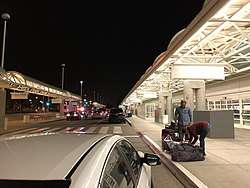 | |||||||||||||||
| Summary | |||||||||||||||
| Airport type | Public | ||||||||||||||
| Owner | Ontario International Airport Authority[1] | ||||||||||||||
| Operator | Ontario International Airport Authority[1] | ||||||||||||||
| Serves | Ontario, California / Inland Empire, California | ||||||||||||||
| Location | Ontario, California | ||||||||||||||
| Hub for | UPS Airlines | ||||||||||||||
| Elevation AMSL | 944 ft / 288 m | ||||||||||||||
| Coordinates | 34°03′22″N 117°36′04″W / 34.05611°N 117.60111°WCoordinates: 34°03′22″N 117°36′04″W / 34.05611°N 117.60111°W | ||||||||||||||
| Website |
www | ||||||||||||||
| Maps | |||||||||||||||
|
FAA airport diagram | |||||||||||||||
 ONT Location within the Los Angeles metropolitan area  ONT ONT (California)  ONT ONT (the US) | |||||||||||||||
| Runways | |||||||||||||||
| |||||||||||||||
| Statistics (2017) | |||||||||||||||
| |||||||||||||||
Ontario International Airport (IATA: ONT, ICAO: KONT, FAA LID: ONT) is a public airport two miles east of downtown Ontario, a city in San Bernardino County, California, US, about 38 miles (61 km) east of Downtown Los Angeles. It is currently owned and operated under a joint powers agreement with the city of Ontario and San Bernardino County.[1] The year 2007 saw the peak in passenger traffic with 7.2 million passengers.[4] More recently, in 2015, 4.2 million passengers used the airport, slightly higher than in 2014 with 4.1 million passengers.[5][6]
In 2015 Southwest Airlines carried 59% of departing passengers.[7]
History
Ontario Municipal Airport
In 1923 a landing field was established east of Central Avenue (3 miles (4.8 km) west of the current airport) on land leased from the Union Pacific Railroad. The airfield was named Latimer Field after an orange-packing company next to the airstrip. An airport was built there by one of the first flying clubs in southern California, the Friends of Ontario Airport. In 1929, the city of Ontario purchased 30 acres (12 ha), now in the southwest corner of the airport, for $12,000, and established the Ontario Municipal Airport.
In 1941 the city bought 470 acres (190 ha) around the airport and approved construction of new runways, which were completed by 1942, with funds from the Works Progress Administration. The 6,200-foot (1,900 m) east/west runway and the 4,700-foot (1,400 m) northeast/southwest runway cost $350,000.[8] On 27 February 1942, an Army Air Corps plane made the first landing at the new airport. By 1943, the airport was an Army Air Corps Lockheed P-38 Lightning training base and North American P-51 Mustang operating base.
After the war the Reconstruction Finance Corporation established five large storage, sales and scrapping centers for Army Air Forces aircraft. These were located at: Albuquerque AAF, New Mexico, Altus AAF, Oklahoma, Kingman AAF, Arizona, Ontario AAF and Walnut Ridge AAF, Arkansas. A sixth facility for storing, selling and scrapping Navy and Marine aircraft was located at Clinton, Oklahoma.
Ontario International Airport
In 1946 Ontario Municipal Airport was renamed "Ontario International Airport" because of the transpacific cargo flights originating there. On 17 May 1946, two Army surplus steel hangars arrived at the airport, which the Ontario city council had authorized the $50,000 purchase of just the previous week. City officials were pleased to have secured a bargain. Thought to be the only pair available in the U.S., City Manager Harold J. Martin observed that even if they could be acquired at a later date, the cost would be several times that afforded by prompt action.[9] A Pacific Overseas Airlines flight from Shanghai arrived at Ontario on 18 May 1946, "which inaugurated regular round-trip air passenger air service between the United States and the orient."[10] In 1949 Western Airlines began scheduled flights; in 1955 Bonanza Air Lines flights started. Western and Bonanza nonstops did not reach beyond Las Vegas. In 1962 Western began nonstop flights to San Francisco (one Electra daily). In 1967 Bonanza began nonstop F27 flights to Phoenix.
Ontario and Los Angeles entered into a joint powers agreement, making Ontario International Airport part of the Los Angeles regional airports system.[11] In 1968 the airport saw its first scheduled jet flights. In 1969 Continental Airlines started 720B nonstops to Denver and Chicago; Air California started 737 flights to San Jose; Pacific Southwest Airlines started San Francisco flights; and Western began 737 nonstops to Sacramento and Salt Lake City. In 1970 United Airlines started a nonstop to Chicago and American started flights to Dallas (and Chicago, for a short time). In September 1986, Ontario hosted the Concorde supersonic airliner during a promotional round-the-world flight.[12]
In 1981 a second east–west runway, 26L/8R, was built, necessitating the removal of the old NE-SW runway 4/22. Remnants of the 4/22 runway are visible in the present-day taxiways. With the completion of the new runway, the existing runway 25/7 became 26R/8L. In 1985, the city of Los Angeles acquired Ontario International Airport outright from the city of Ontario. In 1987, Runway 26R/8L was extended to the east to bring the two runway thresholds side by side, so aircraft would be higher over neighborhoods. 26R/8L became the main departing runway and 26L/8R the main arrival runway.
For a number of years, the airport operated alongside Ontario Air National Guard Station, which was closed as a result of the 1995 Base Realignment and Closure Commission.
In 1998 the new and larger airport terminal opened, designed by DMJM Aviation .[13] Two older terminals, west of the current terminal, the main terminal and a small terminal were discontinued when the new Terminal 2 and Terminal 4 facilities were opened. The old terminals currently house the administration and the USO.
In 2005 and 2006, Runway 26R/8L was repaved, strengthened, and received storm drains and better runway lighting, and additional improvements to taxiway intersections were made.[14]
In 2006, Ontario International Airport became "LA/Ontario International Airport." The "LA" portion was added to remind fliers of Los Angeles and to avoid confusion with the province of Ontario in Canada.[15]
Traffic decline and reversion to local control
The airport's traffic peaked in 2005 with 7.2 million passengers, and remained steady through 2007. Around the time of the 2008 financial crisis, JetBlue suspended service to ONT, and major legacy carriers significantly decreased their passenger volume at the airport.[16] Southwest Airlines transferred a significant portion of its Ontario capacity to Los Angeles International Airport (LAX), making LAX fares more competitive with ONT while being coupled with more attractive frequencies and a wider range of destinations. The surrounding Inland Empire region was hit hard by the financial crisis, with the nearby city of San Bernardino declaring bankruptcy.[17] The airport suffered a 40% decline in traffic between 2007 and 2012,[18] during which time traffic at LAX recovered to surpass pre-recession levels.[16]
Ownership and control of the airport became an issue in late 2010 when the city of Ontario, supported by the Southern California Association of Governments, criticized and questioned LAWA's operation of the airport.[19][20][21] A group of local government officials, led by Ontario city council member Alan Wapner, began a campaign to transfer control of the airport away from Los Angeles World Airports. Wapner argued that the City of Los Angeles had no interest in maintaining service at an airport well beyond its borders.[17] In 2013, LAWA offered to return the airport to local control for a purchase price of $474m, which was rejected.[22] Local groups then sued the city of Los Angeles, a suit that was temporarily suspended when both sides agreed to attempt to work together.[23]
In 2015, Los Angeles World Airports tentatively agreed to turn over ownership of Ontario Airport to the city of Ontario. LAWA was "to be reimbursed for its investments in the facility, job protection for the facility's 182 employees and the settlement of a lawsuit in which Ontario sought to regain control of the airport. Once ownership is transferred, the airport will be operated by the Ontario International Airport Authority, formed under a joint-powers agreement between the city of Ontario and San Bernardino County." The Ontario International Airport Authority took over control of operations in November 2016, and the airport's operating name was reverted to Ontario International Airport since the City of Los Angeles no longer oversaw operations of the airport.[24][25]
The airport's continuing traffic decline reversed in early 2017, when the airport experienced faster growth than LAX for the first time since 2007.[26] On September 30, 2017, it was announced that China Airlines would begin nonstop flights from Ontario to Taipei which started in Spring 2018.[27]
Present-day operations
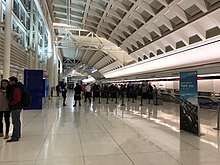
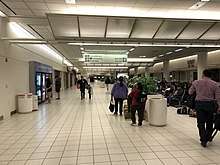
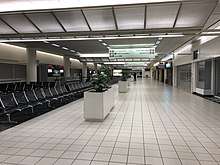
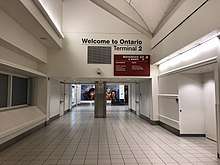
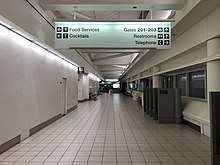
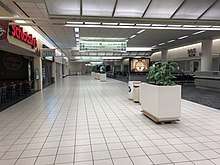
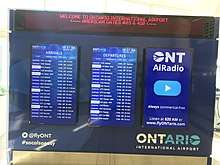
Ontario Airport is owned and operated by the Ontario International Airport Authority. The airport covers 1,741 acres (705 ha) and has two parallel runways.[2] It is the third major airport in the area after Los Angeles International Airport (LAX) and John Wayne Airport (SNA). It is the West Coast air and truck hub for UPS Airlines and is a major distribution point for FedEx Express. Ontario International Airport was a hub for ExpressJet, which began service to 14 destinations in April 2007. This service ended on September 2, 2008.[28] ONT currently has more than 64 daily departures and arrivals.[24]
Thanks to Ontario's long runways (runway 8L/26R is longer than three of the four runways at LAX), it is often an alternate landing site for large aircraft destined for LAX. Due to Ontario's small customs facilities and limited connecting flights, such flights typically do not disembark passengers at Ontario. Diverted aircraft are typically refueled before continuing on to LAX.
The airport is about 38 miles (61 km) east of downtown Los Angeles, 18 miles (29 km) west of downtown San Bernardino and 14 miles (23 km) northwest of downtown Riverside. Motorists can use the San Bernardino Freeway (Interstate 10), Ontario Freeway (Interstate 15), or the Pomona Freeway (State Route 60). It is served by Omnitrans bus routes 61, 80 and by private shuttles.[29] Metrolink's Riverside Line runs to East Ontario at peak commuter hours, but is roughly 2.3 miles away from the terminal.
Alaska Airlines currently flies nonstop to Portland, and Seattle. American Airlines to Dallas (Fort-Worth), and Phoenix Sky-Harbor. China Airlines to Taipei, Taiwan. Delta Airlines to Salt Lake City. Frontier to Austin, Denver, Orlando, and San Antonio. JetBlue to New York-JFK. Southwest to Chicago-Midway, Dallas Love-Field, Denver, Las Vegas, Oakland, Phoenix, Portland, Sacramento, and San Jose. United Airlines to Denver and San Francisco. Volaris to Guadalajara.
The airport has been making a large effort to attract new airlines, including lowering landing fees and new amenities to passengers inside the current terminals. So far, the efforts made have attracted China Airlines, Frontier Airlines, and JetBlue to either begin or resume service to the airport.
Noise restrictions
Ontario has few noise restrictions/abatement[30] rules, unlike other Southern California airports such as John Wayne Airport, Bob Hope Airport, Long Beach Airport, and San Diego International Airport, which all have very strict policies. The airport is allowed to operate 24/7, but during the hours of 10 pm to 7 am all aircraft must arrive from the east on runway 26L or 26R and take-off to the east on runway 8R or 8L, depending on ATC instruction. This procedure is known as "Contra-Flow" operations and applies to turbo-jet or turbo-fan aircraft. This procedure is similar to the one employed by Los Angeles International Airport, where all landings are conducted from the west and all takeoffs are to the west (known as "over-ocean" operations) between midnight and 6:30 a.m. Both of these procedures are employed as long as weather and/or construction activity permits. This is done in an effort to be better neighbors and minimize the noise impact to the surrounding communities as much as possible.
Terminals
Ontario International Airport has two terminals and a separate adjacent international arrivals facility.[31] The terminal numbering scheme was originally designed to accommodate future growth under a prior airport master plan.
Terminal 2 has 265,000 square feet (24,600 m2) and 12 gates (201–212). Terminal 4 has 265,000 square feet (24,600 m2) and 14 gates (401–414). The International arrivals facility has 2 gates for arrivals only, containing a U.S. Customs and Border Protection FIS/Federal Inspection Service. International flights depart from the main terminals.
A USO is housed in the old terminal complex near to the separate international arrivals facility.[32]
Remote parking is located on the east end of the airport (moved from its former location at the west end). On the east end is a ground transportation center that consolidates the rental car companies in one central location. A circulator bus circles the airport and provides connections to each of the terminals, rental car and remote parking lots, and public transit stops.
General aviation is located at the south side of the airport, although most general aviation pilots tend to use a number of nearby airports: Redlands Airport, Chino Airport, Brackett Field in La Verne, Cable Airport in Upland, or San Bernardino International Airport.
Airlines and destinations
Ontario International Airport has a total of 19 passenger destinations, 17 domestic and 2 international (1 in Mexico and 1 in Taiwan). So far, Volaris and China Airlines are the only international airlines that operate at ONT. Airlines operating from terminal 2 include, Alaska Airlines, China Airlines, Delta Air Lines, Frontier Airlines, United Airlines, JetBlue Airways, and Volaris. Airlines in terminal 4 include American Airlines and Southwest Airlines.
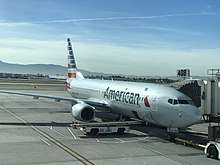
.jpg)
Passenger
Cargo
Statistics
Top destinations
| Rank | Airport | Passengers | Carriers |
|---|---|---|---|
| 1 | Phoenix–Sky Harbor, Arizona | 393,760 | American, Southwest |
| 2 | Oakland, California | 265,510 | Southwest |
| 3 | Sacramento, California | 256,820 | Southwest |
| 4 | Dallas/Fort Worth, Texas | 248,040 | American |
| 5 | Denver, Colorado | 223,560 | Frontier, Southwest, United |
| 6 | San Jose, California | 157,500 | Southwest |
| 7 | Las Vegas, Nevada | 153,500 | Southwest |
| 8 | Seattle–Tacoma, Washington | 148,940 | Alaska |
| 9 | San Francisco, California | 107,530 | United |
| 10 | Portland, Oregon | 95,460 | Alaska, Southwest |
In May of 2018, 12,884 passengers flew to Taipei making it the busiest international route from Ontario, while 8,199 passengers flew to Guadalajara. [37]
Airline market share
| Rank | Airline | Passengers | Share |
|---|---|---|---|
| 1 | Southwest Airlines | 2,649,000 | 57.84% |
| 2 | American Airlines | 775,000 | 16.92% |
| 3 | SkyWest Airlines | 365,000 | 7.98% |
| 4 | Alaska Airlines | 292,000 | 6.37% |
| 5 | United Airlines | 207,000 | 4.53% |
Annual traffic
| Year | Passengers | Year | Passengers | Year | Passengers |
|---|---|---|---|---|---|
| 1992 | 6,121,623 | 2002 | 6,516,858 | 2012 | 4,318,994 |
| 1993 | 6,192,035 | 2003 | 6,547,877 | 2013 | 3,969,974 |
| 1994 | 6,386,000 | 2004 | 6,937,337 | 2014 | 4,127,278 |
| 1995 | 6,405,097 | 2005 | 7,213,528 | 2015 | 4,209,311 |
| 1996 | 6,252,838 | 2006 | 7,049,904 | 2016 | 4,217,366 |
| 1997 | 6,300,862 | 2007 | 7,207,150 | 2017 | 4,552,225 |
| 1998 | 6,434,858 | 2008 | 6,232,761 | ||
| 1999 | 6,578,005 | 2009 | 4,886,695 | ||
| 2000 | 6,756,086 | 2010 | 4,808,241 | ||
| 2001 | 6,702,400 | 2011 | 4,551,875 |
Cargo operations
Ontario is a major southwestern gateway hub for UPS. Over 200 pilots are based at the Ontario hub. Ontario is the UPS Western Region hub for both air and trucking operations within a 13-state region. In addition to serving intra-regional traffic, the hub links to UPS's global hub in Louisville, Kentucky. The Ontario hub processes inbound UPS Next Day Air and UPS 2nd Day Air packages destined for Los Angeles, San Bernardino, Orange, San Diego, Riverside and Ventura counties. It provides outbound package delivery service from homes and businesses in the Inland Valley for delivery to destinations around the world. ONT serves as gateway for UPS' cargo flights to and from China. The Ontario facility sorts and distributes a majority of UPS international packages bound for delivery to the Pacific Rim. Four of the six direct weekly flights flown by UPS to China originate at the Ontario hub.
In popular culture
- In 1946, an airplane "graveyard" located at the airport, containing surplus and retired aircraft from the recent war, was used for a scene in the Samuel Goldwyn film The Best Years of Our Lives.[41]
- In 1961, the exterior terminal building was used for "Lincoln Airport" in the film Back Street starring Susan Hayward and John Gavin.[42]
- In 1968, the airport was used for the film The Counterfeit Killer, starring Jack Lord and Shirley Knight.
- In 2001, the airport was used for the film Blow.
- In 2003, the interior of the terminal was used for the filming of the music video for Kanye West's All Falls Down.
- The interior and exterior of Terminal 1 and the adjacent parking lot were used to portray a 1960s version of Miami International Airport in the 2002 motion picture Catch Me If You Can, starring Leonardo DiCaprio and Tom Hanks.[43]
- The modern airport terminal was used as Charles DeGaulle Airport in Paris, France for the film View From the Top with Gweneth Paltrow in 2003.
- In the same year, 2003, filming took place with Brittany Murphy and Ashton Kutcher in the movie Just Married.
- The old Ontario terminals were used as an interior stand-in for Los Angeles International Airport on the 2004–2006 television series LAX.
- In January 2006, Ontario Airport was featured, by name, in Season 5 of the television drama series 24, in which terrorists took control of the airport and took several hostages.
- The airport and its original terminal building were featured in the final scenes of the 2007 film Zodiac.
- Some of the airport scenes in the episode "Theoretical Love Is Not Dead" in Weeds (TV series) were shot at Ontario Airport.[44]
- The episode Goodbye, Michael of The Office (2011) used one of the new interior terminals.
- Parts of the series Pan-Am (2012–2013) used the interior ticket area of the old airport.
- The final scenes of Argo (2012), were filmed in the interior of the terminal of the old building. This was made to represent the Tehran Airport.[45]
- At least one of the scenes of the movie Saving Mr. Banks (Disney, 2013) utilizes the exterior of the old airport to represent Los Angeles in the early 1960s.[46]
- Ontario was featured on an episode of Top Gear America when heavy duty trucks were towing a Boeing 727.[47]
- The airport was featured on the series finale of Dexter.
- Multiple scenes in the 2013 film Enough Said were shot in the interior of the airport
- In the season 7 premiere of Mad Men, set in 1969, the exterior of the airport is used to show Don Draper's arrival in Los Angeles.[48]
- In Miss Congeniality 2 the old terminal was used for the Vegas airport.
- In the Hangover 2 the airport scenes were filmed in Terminal 2.[49]
References
- 1 2 3
- 1 2 FAA Airport Master Record for ONT (Form 5010 PDF), effective December 20, 2007
- 1 2 "Statistics". Ontario International Airport. January 2017. Retrieved January 30, 2017.
- ↑ "Statistics — Volume of Air Traffic" (PDF). Los Angeles World Airports. December 2005. Retrieved Nov 2, 2016.
- ↑ "Statistics — Volume of Air Traffic" (PDF). Los Angeles World Airports. December 2015. Retrieved Nov 2, 2016.
- ↑ "Statistics — Volume of Air Traffic" (PDF). Los Angeles World Airports. December 2014. Retrieved Nov 2, 2016.
- ↑ "DOT Bureau of Transportation Statistic - Search for December 2015 includes prior 12 months". Retrieved Nov 2, 2016.
- ↑ "Ontario Air National Guard Station". California State Military Museum. Retrieved February 18, 2013.
- ↑ "Ontario Acquires Plane Hangars", The San Bernardino Daily Sun, San Bernardino, California, Saturday 18 May 1946, Volume 52, page 3.
- ↑ Associated Press, The San Bernardino Daily Sun, San Bernardino, California, Sunday 19 May 1946, page 8.
- ↑ "QA Ontario International Airport" (PDF). Los Angeles World Airports. p. 2. Retrieved 1 November 2016.
- ↑ "Concorde Arrives at Ontario--5 Hours Late". Los Angeles Times. 1986-09-22. ISSN 0458-3035. Retrieved 2017-01-17.
- ↑ "Architectural Glass Design". Aecinfo.com. Retrieved September 29, 2018.
- ↑ "Ontario International Airport Runway Construction Project To Begin". April 26, 2005. Retrieved 2 November 2016.
- ↑ "Passenger growth at Ontario airport stagnant - Business - PE.com - Southern California News - News for Inland Southern California". Pe.com. Retrieved September 29, 2018.
- 1 2 "Inland Empire Outlook: Challenges Remain for ONT | The Rose Institute of State and Local Government". Roseinstitute.org. Retrieved 2018-09-19.
- 1 2 Witz, Billy (2013-09-02). "Recession Reverses California Airport's Growth". The New York Times. Retrieved 2018-09-19.
- ↑ "Report Warns of Steep Traffic Decline at Ontario Airport". KTLA. 2013-08-05. Retrieved 2018-09-19.
- ↑ "Locals Want to Run Ontario Airport". Nbclosangeles.com. Retrieved September 29, 2018.
- ↑ "Ontario: L.A. should relinquish control of Ontario Airport, Daily Breeze". Dailybreeze.com. Retrieved September 29, 2018.
- ↑ "Regional support for Inland control of Ontario airport, The BizPress". Inlandsocal.com. Retrieved September 29, 2018.
- ↑ "Ontario rejects $474 million offer for airport". Dailybulletin.com. April 11, 2013. Retrieved September 29, 2018.
- ↑ "Los Angeles should work with Ontario on L.A./Ontario International Airport, Sen. Dianne Feinstein says". Dailybreeze.com. December 19, 2013. Retrieved September 29, 2018.
- 1 2 "Airport Information - Ontario International Airport". Flyontario.com. Retrieved September 29, 2018.
- ↑ Weikel, Dan. "Ontario officials get ownership of international airport and pledge more flights and services - Los Angeles Times". Latimes.com. Retrieved September 29, 2018.
- ↑ "What the latest passenger numbers at Ontario airport did in March that they haven't done in a decade". Daily Bulletin. 2017-04-28. Retrieved 2018-09-19.
- ↑
- ↑ Hamilton, Dane (July 9, 2008). "ExpressJet suspends commercial operations". Reuters.
- ↑ Scauzillo, Steve (April 28, 2014). "Gold Line to Ontario Airport off track; bill withdrawn by author". San Gabriel Valley Tribune. Retrieved 2014-12-05.
- ↑ "Noise Management - Ontario International Airport". Flyontario.com. Retrieved September 29, 2018.
- ↑ "Airport Overview - Ontario International Airport". Flyontario.com. Retrieved September 29, 2018.
- ↑ "Bob Hope USO Ontario - The Bob Hope USO". Bobhopeuso.org. Retrieved September 29, 2018.
- ↑ "China Airlines launches daily Taipei – Ontario service from Mar 2018". RoutesOnline.com. December 20, 2017. Retrieved December 20, 2017.
- ↑ "Frontier schedules additional 15 routes in August 2018". RoutesOnline.com. June 2018. Retrieved June 14, 2018.
- ↑ "JetBlue to return to Ontario Airport with flights to New York". Daily Bulletin. April 2018. Retrieved April 26, 2018.
- ↑ "RITA | BTS | Transtats". Transtats.bts.gov. Retrieved July 29, 2018.
- ↑ "Ontario International Airport : Calendar May and YTD" (PDF). Fylontario.com. Retrieved 29 September 2018.
- ↑ "RITA | BTS | Transtats". Transtats.bts.gov. May 2011. Retrieved February 22, 2017.
- ↑ "LAX - Welcome to Los Angeles International Airport". Lawa.org. Retrieved September 29, 2018.
- ↑ "ONTARIO: Airport passenger, cargo volumes climbed in 2015". Pe.com. January 26, 2016. Retrieved September 29, 2018.
- ↑ "The Best Years of Our Lives (1946)". IMDb.com. Retrieved September 29, 2018.
- ↑ "Back Street (1961)". IMDb.com. Retrieved September 29, 2018.
- ↑ Frasher, Steven Airport Serves as Backdrop for Hollywood Movie Scenes 'Press Enterprise' - Retrieved January 27, 2016
- ↑ "Ontario airport film-friendly for advertisers". Press Enterprise. 2010-11-19. Retrieved 2018-05-21.
- ↑ Verrier, Richard L.A. plays Tehran in Ben Affleck caper 'Argo' 'Los Angeles Times' - Retrieved January 27, 2016
- ↑ City of Ontario Need to do some star watching? No need to go to Hollywood 'Ontario EDA' - Retrieved January 27, 2016
- ↑
- ↑ Evan, Maria Here Are the Actual Sites From "Mad Men's" Season 7 Premiere 'Franklin Avenue' - Retrieved January 27, 2016
- ↑ "The Hangover Part II (2011)". IMDb.com. Retrieved September 29, 2018.
External links
| Wikimedia Commons has media related to Ontario International Airport. |
- Official Ontario International Airport website
- Ontario International Airport Master Plan
- openNav: ONT / KONT charts
- Weikel, Dan. "Los Angeles Times: "As use dwindles, calls grow for local control of Ontario airport" — 31 October 2011 article.
- FAA Airport Diagram (PDF), effective October 11, 2018
- Resources for this airport:
- AirNav airport information for KONT
- ASN accident history for ONT
- FlightAware airport information and live flight tracker
- NOAA/NWS latest weather observations
- SkyVector aeronautical chart for KONT
- FAA current ONT delay information
